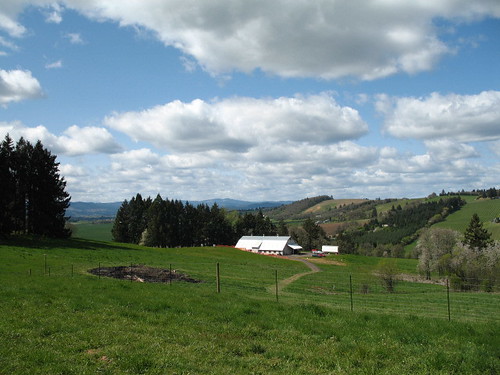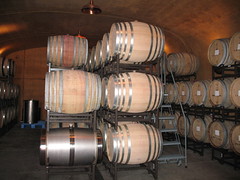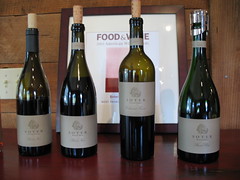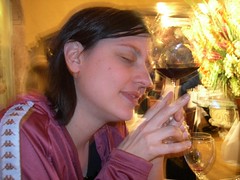James Cahill, Soter Vineyards

See this stellar photo? James Cahill wasn't sure if I should take it or not. "The building is a mess right now," he insisted. I guess he meant that orange construction fence in front...see it? Yeah, neither did I. I was too busy taking in the bucolic splendor of the Yamhill-Carlton district. A bit of farm equipment, an old car or two, and an orange fence aren't close to distracting.
 James is the associate winemaker for the Soter family, and Beacon Hill Vineyard is his charge. As we ascend the hill from which the above photo was taken, he tells me about every square inch of the land. We cross a large patch of soft, knee-high grass and milkweed and James builds an 8x10 in color for me of the sheep that are summoned for mowing it every so often, and how it will eventually support more Pinot Noir vines. He points to an area nearby: this is the place for a future tasting room. We stand on the edge of the hill and look down on rich farmland, and he tells me everything about the history, both ancient and recent, of this district. And that's before we've even gotten to the vineyard. This is a guy who clearly loves what he does and where he's doing it, and his enthusiasm is refreshing. It's also clear that he's got a great deal of admiration for Tony Soter, the master and commander of the family label. He speaks about Mr. Soter's vision as often as he does his own, and the two seem perfectly suited.
James is the associate winemaker for the Soter family, and Beacon Hill Vineyard is his charge. As we ascend the hill from which the above photo was taken, he tells me about every square inch of the land. We cross a large patch of soft, knee-high grass and milkweed and James builds an 8x10 in color for me of the sheep that are summoned for mowing it every so often, and how it will eventually support more Pinot Noir vines. He points to an area nearby: this is the place for a future tasting room. We stand on the edge of the hill and look down on rich farmland, and he tells me everything about the history, both ancient and recent, of this district. And that's before we've even gotten to the vineyard. This is a guy who clearly loves what he does and where he's doing it, and his enthusiasm is refreshing. It's also clear that he's got a great deal of admiration for Tony Soter, the master and commander of the family label. He speaks about Mr. Soter's vision as often as he does his own, and the two seem perfectly suited.Beacon Hill is the flagship Pinot Noir producer for Tony Soter, a beautiful 22-acre spread with blocks of vines planted as recent as 2004 and early as 1988. The original Pinot Noir vines are Pommard clones on their own rootstocks (non-geeks read: kickass French vines chosen for maximum goodness), and there are other "heirloom" clones as well. There's also a block or two of Chardonnay from '89, which goes into their sparkling wines.
The buds are just barely starting to break, and as we go along, Jim shows me what kind of detail work is done. "Human hands have to touch every vine," he says, pointing to the tiny buds at the base of the vine. These have to be shorn away so that the plant focuses on the buds above, and it's not something that can be done by a machine.
James is easy to talk to, and helps me put together a picture of sustainable farming. I'm still chewing on Allen Holstein's opinions from earlier in the day: that so-called 'organic' farming is often more of a marketing ploy than something that leads to the best possible wine. Part of my trip is to put aside anything I've learned or read about viniculture, shut up, and pay attention to what everyone says. It's really the only way to get the real picture.
James and the Soter family are dedicated to the sustainable practices on their land, and have received certification from L.I.V.E (Low Input Viniculture and Enology, Inc) for their practices. Does this mean they don't use a single wee drop of herbicide ever? No. It does mean that they do not use persistent herbicides, ones that linger for years in the soil. Sustainable farming practices are different from strict organics, but the idea is the same: make choices based on minimizing the enviornmental footprint you leave on the land, and your land will produce great fruit for decades to come.
 We visit the cave after our hike through the vines, a structure built into the hillside for resting bottles of bubbly and barrels of Pinot. Then it's off to taste some of the finished product. Chris Poulos, the Soter sales and marketing guy, takes over as James excuses himself to attend to some business. Chris tells me about the two vineyards, the Beacon Hill and the Soter's newest Mineral Springs Vineyard, and pours me some vino.
We visit the cave after our hike through the vines, a structure built into the hillside for resting bottles of bubbly and barrels of Pinot. Then it's off to taste some of the finished product. Chris Poulos, the Soter sales and marketing guy, takes over as James excuses himself to attend to some business. Chris tells me about the two vineyards, the Beacon Hill and the Soter's newest Mineral Springs Vineyard, and pours me some vino.I tasted five wines, all of which lived up to the stories, methods and care about which I'd been told. The 1999 Brut Rose was billed by Chris as the "best sparkler in America". I don't know about that, but it was fantastic. It's big and intense with fruit, creaminess, spice and superfine pearlage. Damn fine stuff. Grab it if you see it.

The Pinots were silky and busting at the seams with aroma, spice and personality. And none of the wines, to my delight, were way up high in alcohol. Even the ultra hot (and therefore, ultra ripe) 2003 vintage came in just a hair's-breadth over 14%. These are Pinots made by someone who loves the elegance of Pinot, and it shows. My fave was the 2004 North Valley Pinot Noir: killer structure, silkalicious, and only poised to improve with age.
The 2002 'Little Creek' Blend, mostly Cab Franc did not suck either. Juicy and earthy at the same time, big without shouting, great balance.
James Cahill spent several years living in Austin, and when he returned, we chatted about all the people we knew and where'd we go eat right then if we were there. It was good to talk to someone who knew Austin; homesickness is creeping up on me gradually and making visions of picadillo tacos and migas and margaritas dance about in my head. As I bade James goodbye, I wondered if I could leave that all behind to live in the lush green landscape of Willamette.
Tempting. But nah.
Next up: Harry Peterson-Nedry of Chehalem uses a chunk of his rare time to chat with me at a coffee house. Such a nice guy. Stay tuned.





2 Comments:
Taj, Nice work on the Allen Holstein and James Cahill articles. I just wanted to mention how cool it is that James talked about LIVE and its efforts and how disappointed I am that Allen Holstein, a LIVE board member for two years now, didn't say anything about sustainability. Bummer.
Hi Jim,
Just wondering where you decided on the name Soter Vineyards. My family name is Soter and it is Hungarian. Let me know.
Post a Comment
<< Home